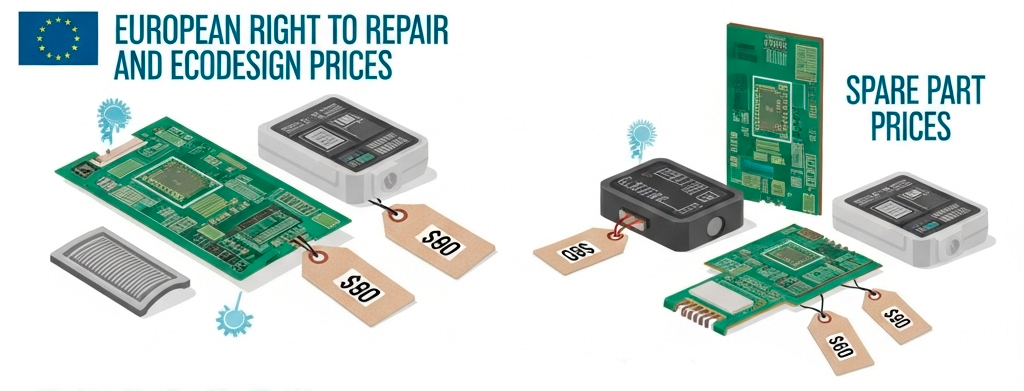How the new European Right to Repair and Ecodesign rules will change the price of spare parts
Publicado por Pablo1?? What is happening?
2025 will be a turning point for the electronic repair sector in Europe. Two major legal frameworks converge:
- ? Directive (EU) 2024/1799 on promoting repair, effective from July 30, 2024; mandates offering spare parts ?at a reasonable price? and extends the warranty by one year if the consumer repairs.
- ?? Ecodesign & Energy Label Regulations: starting June 20, 2025, smartphones and tablets will display their repairability score.
The coalition Right to Repair Europe has published a position paper detailing how to implement these obligations in terms of pricing and transparency.
2?? Price commitment: goodbye to surprise hikes ?
The white paper proposes that the maximum price declared by the manufacturer be a legal cap throughout the spare part's availability period:
- ? If a display is advertised at ?99, it cannot increase within three years.
- ? The list must be public, searchable by model, and only adjustable for inflation.
- ?? There will be penalties or compensation rights if violated.
Direct impact for your workshop:
- ? More reliable quotes.
- ? Fewer ?irreparable? diagnoses due to spare parts doubling in price.
3?? Price becomes part of the Repairability Index ?
The European proposal mirrors the French logic: the lower the percentage of the spare part's price relative to the retail price (RRP), the higher the score.
| ?? Spare part/RRP Ratio | ? Points |
|---|---|
| ? 10 % | 10 |
| 10 % < R ? 12 % | 9 |
| ? | ? |
| 26 % < R ? 28 % | 1 |
| > 28 % | 0 |
4?? Other updates you should know ?
| ? Topic | ? What changes | ? How it affects you |
|---|---|---|
| ?Bundling? | Penalizes selling only the full module if the single part can be replaced. | ?? More modular repairs and smaller parts. |
| Delivery time | Priority spare parts within 5-10 business days. | ?? Fewer stock shortages. |
| Full transparency | Visible prices in EPREL or via QR code at the point of sale. | ? You can show the official price to the client in seconds. |
| Post-repair warranty | Repairing extends the legal warranty by 12 months. | ? Additional sales argument. |
5?? Practical tips for stores and repair centers ?
- ? Update your ERP to import the official price ceilings.
- ? Adjust your stock to a ?just-in-time? model.
- ??? Train your team in micro-soldering and glass replacement.
- ? Highlight the extended warranty in your marketing.
- ? Negotiate with suppliers price cap clauses.
6?? What to expect in the medium term? ?
- ? June 2025 ? Mandatory repairability label.
- ? July 2026 ? ?Reasonable? prices enforceable for all products with Ecodesign requirements.
- ?? 2025-2027 ? Extension of the methodology to laptops, printers, appliances, etc.
7?? Strategic reflections and real cases ?
The white paper figures debunk the idea that stable prices are impossible:
- ? Fairphone has maintained virtually the same spare part prices for a decade.
- ? Groupe SEB guarantees repair of any appliance for < 33 % of the cost of a new one for 15 years, already covering 90 % of its catalog.
- ?? The LONGTIME® label requires parts to not exceed, on average, 25 % of the RRP; hundreds of certified products meet this standard.
From the perspective of the circular economy, these precedents demonstrate that:
- ?? Price commitment is viable and improves consumer trust.
- ? Facilitates climate goals: each repair avoids between 35-55 kg of CO?e according to ADEME.
- ? Reduces planned obsolescence and levels the playing field between manufacturers and independent repair centers.
8?? What do consumers think? ??
- ? 68 % cite ?spare part price? as the main barrier to repair.
- ? Only consider repair if the total cost < 30 % of the product's RRP.
- ?? 88 % expect the repairability index to reflect the real price of parts.
Reflection: if your technical service manages to stay below these thresholds, your quote acceptance rate will drastically increase.
9?? Risks and challenges ??
While the new framework favors repair, it also presents challenges:
- ? Reduced margin for manufacturers relying on expensive spare parts sales.
- ?? Potential logistics saturation if all repair centers request ?just-in-time? parts simultaneously.
- ? Greenwashing: if price is not included horizontally, products could show an A without being truly repairable.
The regulation will align incentives so that repairing becomes, finally, the default option. Companies that get ahead ? with transparency, training, and efficient processes ? will be the ones to capitalize on this new scenario.
? Let?s get repairing! ??








